high priest garments symbolism pdf
The High Priest’s garments are rich in symbolic meaning, reflecting divine purity, royalty, and holiness․ They embody Israel’s spiritual identity and serve as tools of intercession, connecting heaven and earth․
Overview of the Importance of Priestly Attire
Priestly attire holds profound significance, symbolizing purity, holiness, and the priest’s role as a mediator between God and humanity․ These garments, meticulously designed, reflect the grandeur of divine service and the sacred responsibilities entrusted to the priests․ They embody the ideals of righteousness and separation unto God, ensuring the priests’ worthiness to perform rituals and sacrifices․ The attire’s intricate details and symbolic elements emphasize the priests’ divine calling and their representation of the people before God, fostering a deeper connection between heaven and earth․
Historical Context of the High Priest’s Wardrobe
The High Priest’s garments were first described in Exodus 28, outlining their precise design and materials․ These sacred robes, including the ephod and breastplate, were crafted under divine instruction, emphasizing their holy purpose․ Historically, they were worn during Temple services, symbolizing the priest’s role as a mediator and intercessor․ The attire’s splendor and specificity underscored the gravity of their duties, serving as a visual reminder of God’s presence and the people’s covenant with Him, rooted in ancient tradition and spiritual significance․
The Ephod: A Symbol of Power and Connection
The Ephod, made of gold, blue, purple, and scarlet yarns, and fine linen, symbolized divine authority and connection, representing the High Priest’s role in uniting God and Israel․
Materials and Design of the Ephod
The Ephod was crafted from gold, blue, purple, and scarlet yarns, and fine linen, symbolizing divine purity and royalty․ Its intricate design featured woven patterns, emphasizing craftsmanship and sacred purpose․ The Ephod’s material richness and precise construction reflected its role as a vital instrument of divine connection, embodying both aesthetic beauty and spiritual significance in the High Priest’s attire․
Symbolism of the Ephod in Ritual and Worship
The Ephod symbolized the High Priest’s role as a mediator between God and humanity, facilitating divine communication․ It represented the unity of the tribes of Israel through its twelve precious stones, each engraved with a tribe’s name․ During rituals, the Ephod carried the Urim and Thummim, tools for seeking God’s guidance, embodying spiritual authority and the priest’s responsibility to discern divine will, ensuring harmony and governance among the people․
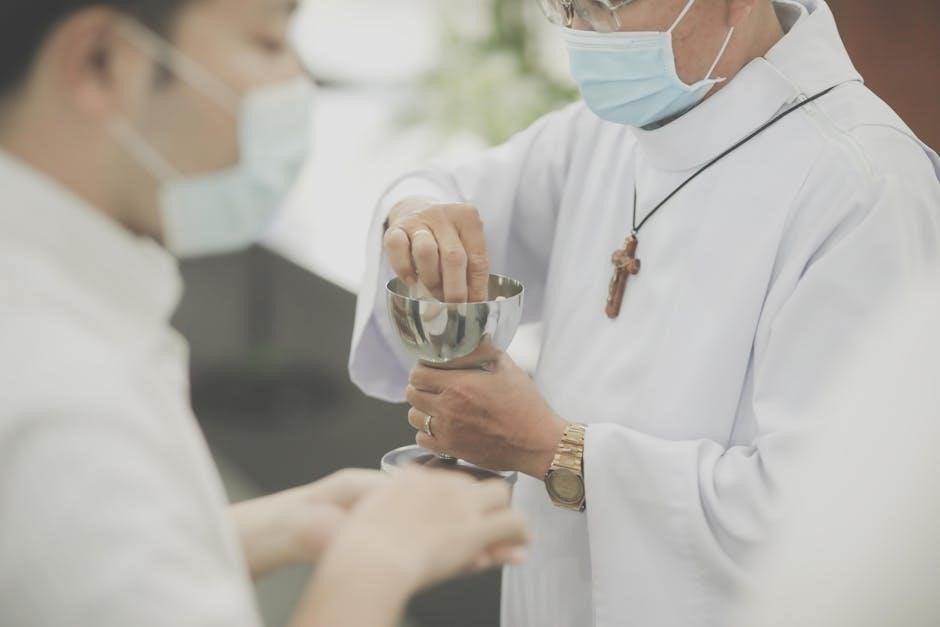
The Breastplate of Decision: Representing Divine Guidance
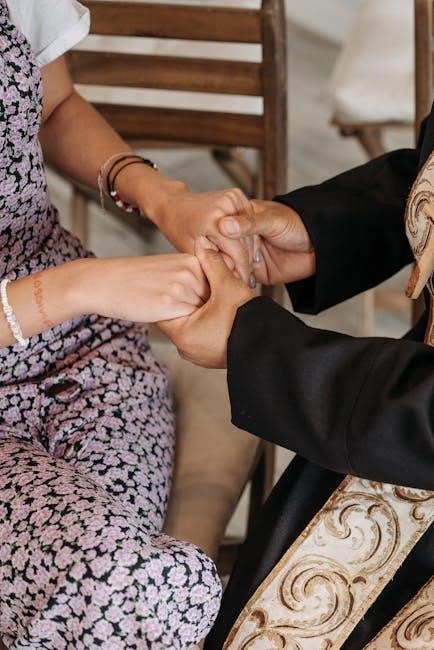
The breastplate, placed over the Ephod, held the Urim and Thummim, symbolizing divine wisdom and guidance in Israel’s decisions and sacred rituals․
Construction and Placement of the Breastplate
The breastplate, crafted from finely woven materials, was securely fastened to the Ephod, resting over the High Priest’s heart․ Its intricate design featured twelve precious stones, each engraved with the names of Israel’s tribes, symbolizing unity and divine presence․ Placed centrally, it signified the priest’s role in seeking God’s will, ensuring every decision reflected heavenly guidance and maintained harmony among the people․
Significance of the Urim and Thummim
The Urim and Thummim were sacred tools within the High Priest’s breastplate, used to discern God’s will․ Their placement allowed the High Priest to seek divine guidance, ensuring decisions aligned with God’s intentions․ Symbolizing light and perfection, they represented clarity and righteousness in leadership․ These instruments were crucial in maintaining the covenant, providing divine direction during critical times and reinforcing the High Priest’s role as a mediator between God and the Israelites effectively․
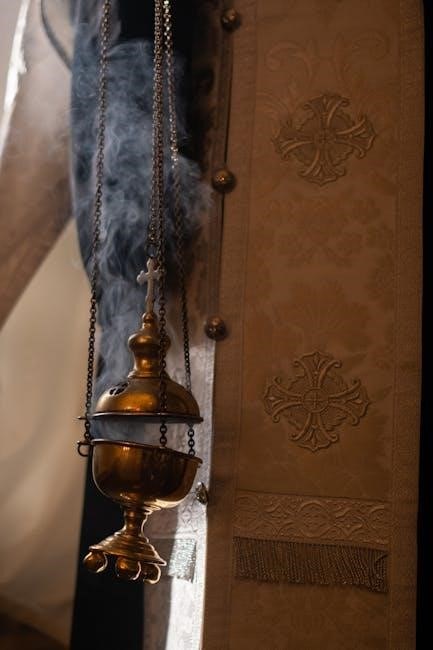
The Robe of the Ephod: Bells and Pomegranates
The robe of the Ephod featured golden bells and pomegranates, symbolizing divine presence and joy․ The bells signified the High Priest’s approach to God, ensuring safety during rituals, while the pomegranates represented abundance, righteousness, and divine fertility, embodying God’s fruitful covenant with Israel․
Symbolism of the Golden Bells and Pomegranates
The golden bells and pomegranates on the robe symbolized divine presence and spiritual abundance․ The bells announced the High Priest’s movement, ensuring safety and reverence, while the pomegranates, with their many seeds, represented fertility, righteousness, and divine covenant․ Together, they signified joy, abundance, and the fruitful spiritual life of Israel, embodying God’s promises and the priest’s role in maintaining sacred rituals and communal holiness․
Function of the Robe in Ceremonial Practices
The robe played a vital role in ceremonial practices, ensuring the High Priest’s safety and Reverence․ The golden bells announced his movements, preventing sudden appearances that could alarm others․ The pomegranates symbolized spiritual abundance and divine fruitfulness․ Worn during rituals, the robe emphasized the priest’s sacred duties, safeguarding his work in the Holy Place and reinforcing the sanctity of his ministerial role in maintaining Israel’s covenant with God and ensuring communal atonement․
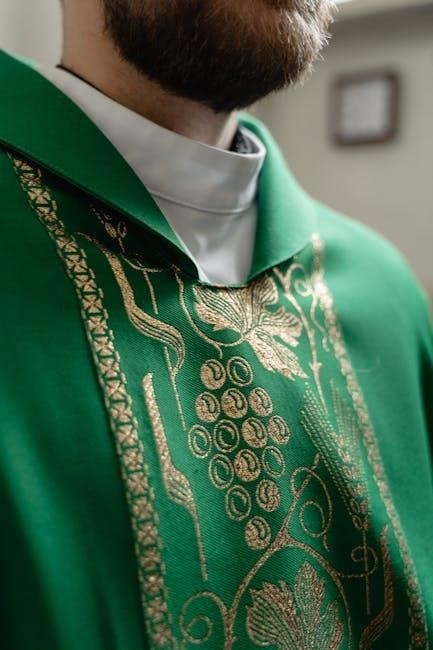
The Turban and the Plate of Gold
The turban and gold plate symbolized divine authority and holiness․ The plate, engraved with “Holiness to the Lord,” signified the priest’s sacred role and subjection to God․
Design and Meaning of the Turban
The turban, worn by the High Priest, featured a gold plate engraved with “Holiness to the Lord,” symbolizing divine authority and the priest’s sacred role; Its design, pointing upward, signified spiritual ascent and subjection to God․ The turban embodied dignity and beauty, reflecting the priest’s royal and holy status․ It served as a visible reminder of the priest’s responsibility to represent the people before God, emphasizing purity and righteousness in service․
Significance of the Plate Engraved with “Holiness to the Lord”
The gold plate engraved with “Holiness to the Lord” symbolized the High Priest’s dedication to divine service and his role as a mediator․ It signified the priest’s sacred responsibility to represent the people before God, embodying purity and righteousness․ The plate served as a constant reminder of God’s holiness and the priest’s commitment to uphold it, ensuring his actions reflected divine authority and sacred duty․
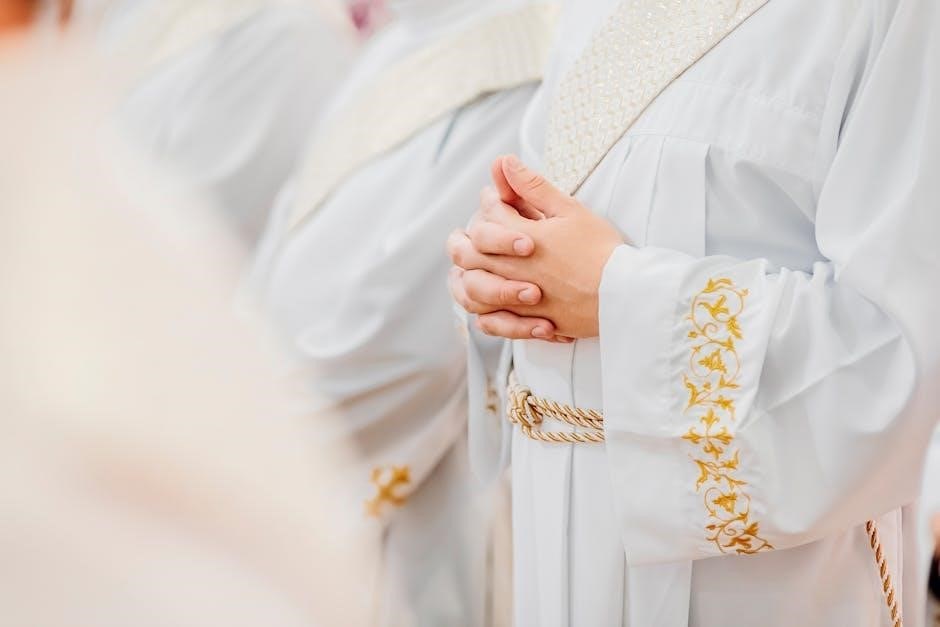
The Tunic and Pants: Garments of Purity
The tunic, made of fine linen, symbolized purity and righteousness, while the pants ensured modesty, together representing the priest’s holy and sanctified state before God․
Materials and Symbolism of the Tunic
The tunic was crafted from fine woven linen, symbolizing purity and righteousness․ Its design and material represented the priest’s role as a mediator, embodying holiness and divine connection․ The tunic’s simplicity and elegance reflected the priest’s humble yet sacred service, while its fine linen signified the covering of Christ’s righteousness, emphasizing the priest’s spiritual purity and readiness to serve God․
Role of the Pants in Maintaining Modesty and Sanctity
The pants, made of fine linen, ensured modesty and sanctity, covering the priest’s lower body․ They symbolized moral integrity and humility, essential for those serving in holy rituals․ The pants also represented purity of heart and actions, aligning with the priest’s role as a mediator between God and His people․ This attire emphasized the importance of inward and outward holiness, reflecting the divine standards required for sacred service․
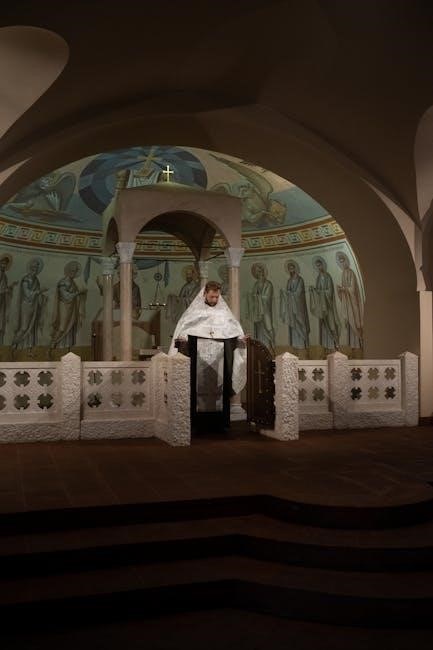
The Symbolism of Colors in High Priest Garments
Gold symbolizes divine purity, while blue, purple, and scarlet represent heaven and royalty․ Linen and fine fabrics embody purity and righteousness, reflecting God’s holiness and the priest’s sacred role․
Gold as a Symbol of Divine Purity
Gold in the High Priest’s garments symbolizes divine purity and royalty, reflecting God’s holiness․ It was used in the ephod, breastplate, and other key elements, signifying the priest’s sacred role․ The shimmering metal represented the divine light and perfection, emphasizing the priest’s connection to the sacred․ Gold’s incorruptible nature also mirrored the eternal purity of God, making it a fitting material for garments worn during holy rituals and ceremonies․
Blue, Purple, and Scarlet: Representing Heaven and Royalty
Blue, purple, and scarlet threads in the High Priest’s garments symbolized heaven’s majesty and royal authority․ Blue represented divine revelation and heaven’s splendor, while purple signified royalty and richness․ Scarlet, often linked to sin and redemption, underscored the need for atonement․ Together, these colors reflected the priest’s role as a mediator between God and humanity, embodying both divine authority and the profound spiritual truths of God’s covenant with Israel․
Linen and Fine Woven Fabrics: Purity and Righteousness
Linen and fine woven fabrics symbolized purity and righteousness in the High Priest’s attire․ Derived from flax, linen represented cleanliness and innocence, while the intricate weaving signified meticulous adherence to divine standards․ These materials emphasized the priest’s role as a holy vessel, set apart for sacred service․ The use of such fabrics underscored the importance of moral integrity and spiritual cleanliness in those who ministered before God, reflecting the divine expectation of holiness in worship and service․

The High Priest as a Mediator: Symbolism in Garments
The High Priest’s garments symbolized his role as a mediator between God and humanity, embodying divine intercession and spiritual connection․ They represented purity, authority, and sacred service․
Garments as Tools of Intercession
The High Priest’s garments were essential tools for intercession, enabling him to mediate between God and Israel․ The ephod and breastplate, adorned with precious stones, facilitated divine communication, while the golden bells and pomegranates on the robe symbolized righteousness and atonement․ These garments not only reflected the priest’s sacred role but also ensured his safety and purity during rituals, embodying the profound connection between heaven and earth in worship and sacrifice․
Representation of the People Before God
The High Priest’s garments symbolized the people’s presence before God, with the breastplate bearing the names of Israel’s tribes, signifying their collective representation․ Each piece of attire, from the turban to the robe, carried specific meanings that reflected the community’s sanctity and covenant with God․ This representation emphasized the priest’s role as a mediator, ensuring the people’s sins were atoned for and their prayers heard, embodying the divine connection between God and His chosen people․
Christological Symbolism in High Priest Garments
The High Priest’s garments foreshadowed Christ as the ultimate High Priest and Savior, with the ephod, breastplate, and robe symbolizing His priestly role, divine nature, and sacrificial ministry․
Jesus as the Ultimate High Priest
Jesus embodies the fulfillment of the High Priest’s role, mediating between God and humanity․ His ministry mirrors the symbolism of the priestly garments, representing divine purity, righteousness, and sacrificial love․ Through His atonement, Jesus became the perfect intercessor, surpassing the earthly priesthood․ The garments’ intricate designs and materials foreshadowed His divine nature and mission, illustrating how He serves as the eternal High Priest, offering redemption and reconciliation to all․
Garments as Foreshadowing of Christ’s Ministry
The High Priest’s garments symbolized Christ’s divine nature and redemptive mission․ The ephod and breastplate represented His role as mediator, while the robe’s bells and pomegranates signified His righteousness and fruitfulness․ The turban’s golden plate, engraved with “Holiness to the Lord,” prefigured Christ’s sinless purity․ These garments foreshadowed His sacrificial death, resurrection, and eternal priesthood, embodying the ultimate atonement and reconciliation between God and humanity through His perfect righteousness and divine intercession․
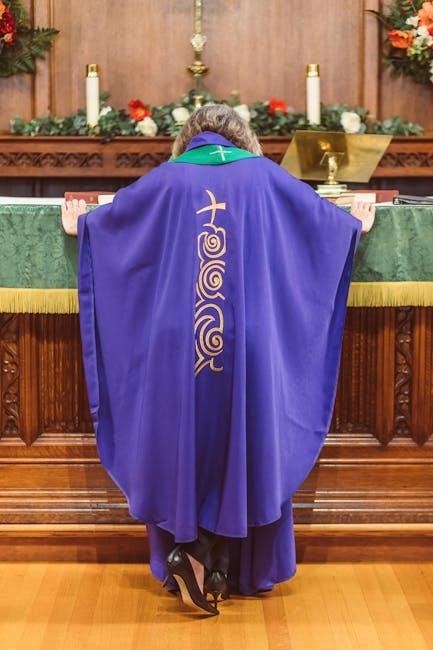
Spiritual Significance of the Garments
The High Priest’s garments symbolize purity, righteousness, and holiness, reflecting the divine nature of God and the priest’s sacred role in worship and intercession․
Purity and Righteousness in Service to God
The High Priest’s garments symbolize purity and righteousness, essential for divine service․ The tunic, made of fine linen, represents Christ’s perfect righteousness, covering humanity’s imperfections․ The pants, worn beneath, signify modesty and sanctity, emphasizing moral purity․ Together, these garments reflect the divine standard of holiness required for those who serve God, embodying the priest’s role as a mediator between God and humanity․
Garments as a Reflection of God’s Holiness
The High Priest’s garments mirrored God’s holiness through their intricate design and materials․ The ephod and breastplate, made of gold and precious stones, symbolized divine purity and glory․ The use of blue and purple dyes reflected heavenly royalty, while fine linen represented righteousness․ These elements collectively embodied God’s sacred nature, emphasizing the priest’s role as a vessel of divine presence․ The garments thus served as a visual testament to God’s transcendent holiness and the priest’s sacred duty to uphold it․
The Role of Atonement Symbolized in the Attire
The High Priest’s garments symbolized atonement through their design and purpose․ The tunic and pants represented covering for sin, while the turban signified intercession․ The ephod and breastplate, with their precious stones, embodied the burden of sin, reminding the priest of his role in atoning for the people․ These garments visually represented God’s mercy and the need for purification, foreshadowing Christ’s ultimate sacrifice as the perfect atonement for humanity’s sins, emphasizing redemption and divine forgiveness․
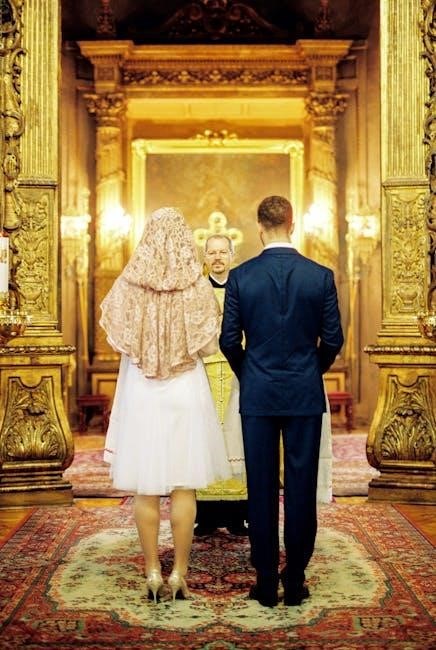
Modern Relevance of High Priest Garments Symbolism
The High Priest’s garments inspire modern spiritual leaders to embody integrity and purity, while their symbolism enriches contemporary worship, fostering a deeper connection to divine service and community․
Lessons for Modern-Day Spiritual Leaders
The High Priest’s garments offer timeless lessons for modern spiritual leaders, emphasizing integrity, humility, and purity․ The intricate designs symbolize the need for leaders to be set apart, yet deeply connected to their community․ The garments’ focus on holiness and divine connection encourages leaders to prioritize spiritual authenticity and intercession․ They also highlight the importance of humility, as the High Priest’s role was to mediate on behalf of others, reflecting a selfless dedication to serving both God and humanity․ These principles remain vital for contemporary spiritual guidance․
Applying Symbolism to Contemporary Worship Practices
The symbolism of the High Priest’s garments can inspire contemporary worship practices by emphasizing sacredness and intentionality․ Modern worship teams can adopt similar principles by using attire or visuals that reflect purity, royalty, and divine connection․ The garments’ focus on unity and representation can translate into inclusive worship services that symbolize the collective priesthood of believers․ Incorporating symbolic elements, such as specific colors or designs, can deepen congregational engagement and create a sacred atmosphere, bridging ancient traditions with modern expressions of worship․
The High Priest’s garments hold profound significance, symbolizing purity, divine connection, and holiness; Their intricate design reflects sacred truths, leaving a lasting legacy in religious thought and worship practices․
Summarizing the Profound Meaning of High Priest Garments
The High Priest’s garments symbolize divine purity, holiness, and the connection between heaven and earth․ Their intricate design, with gold, blue, purple, and scarlet, represents royalty and heaven․ The ephod, breastplate, and robe embody spiritual truths, foreshadowing Christ’s role as the ultimate High Priest․ These garments reflect humanity’s ideal role and God’s expectation of holiness, serving as a timeless reminder of sacred service and intercession․
The Enduring Legacy of Priestly Attire in Religious Thought
The High Priest’s garments have left an indelible mark on religious thought, symbolizing the bridge between the divine and human realms․ Their intricate design reflects the ideal of humanity’s holiness and connection to God․ These garments have inspired imagery in Christianity, such as Christ as the ultimate High Priest, and influenced traditions in other faiths․ Their legacy endures, reminding believers of the necessity of purity, righteousness, and sacred service, continuing to inspire spiritual reflection and worship practices across generations․